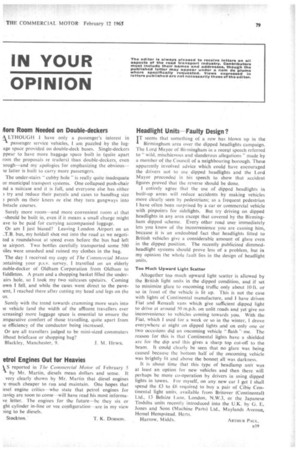IN YOUR OPINION
Page 81

If you've noticed an error in this article please click here to report it so we can fix it.
lore Room Needed on Double-deckers
LTHOUGH 1 have only a passenger's interest in -1 passenger service vehicles, I am puzzled by the lugage space provided on double-deck buses. Single-deckers ppear to have more baggage space built in (quite apart rom the proposals re trailers) than double-deckers, even tough—and my apologies for emphasizing the obvious— le latter is built to carry more passengers.
The under-stairs cubby hole is really quite inadequate or municipal transport systems. One collapsed push-chair nd a suitcase and it is full, and everyone else has either 3 try and reduce their parcels and cases to handbag size ) perch on their knees or else they turn gangways into bstacle courses.
Surely more room--and more convenient room at that -should be built in, even if it means a small charge might ave to be paid for carrying accompanied luggage. Or am I just biased? Leaving London Airport on an
bus, my holdall shot out into the road as we negotited a roundabout at speed even before the bus had left le airport. Two bottles carefully transported some 500 tiles were smashed and ruined my clothes in the bag. The day I received my copy of The Commerclal Motor antaining your p.s.v. survey, I travelled on an elderly ouble-decker of Oldham Corporation from Oldham to 1iddleton. A pram and a shopping basket filled the underairs hole, so I took my two suitcases upstairs. Coming own I fell, and while the cases went direct to the pavetent, I reached there after cutting my head and legs on the us.
Surely with the trend towards cramming more seats into te vehicle (and the width of the affluent travellers ever [creasing) more luggage space is essential to ensure the tmparative comfort of those travelling, quite apart from te efficiency of the conductor being increased.
Or are all travellers judged to be mini-sized commuters ithout briefcase or shopping bag? Blackley, Manchester, 9. J. M. IIEws.
etre' Engines Out for Heavies
S reported in The Commercial Motor of February 5 by Mr. Martin, diesels mean dollars and sense. It very clearly shown by Mr. Martin that diesel engines .e much cheaper to run and maintain. One hopes that lesel engine critics—who state that petrol engines for .tavie, are soon to come—will have read his most informave letter. The engines for the future—be they six or ght cylinder in-line or vee configuration—are in my view ting to be diesels.
Stockton.. T. K. DOBSON.
Headlight Units—Faulty Design ?
I T seems that something of a row has blown up in the Birmingham area over the dipped headlights Campaign. The Lord Mayor of Birmingham in a recent speech referred to" wild, mischievous and slanderous allegations" made by a member of the Council of a neighbouring borough. These apparently involved advice which could have encouraged the drivers not to use dipped headlights and the Lord Mayor proceeded in his speech to show that accident figures proved that the reverse should be done. I entirely agree that the use of dipped headlights in built-up areas will reduce accidents by making vehicles more clearly seen by pedestrians; as a frequent pedestrian I have often been surprised by a car or commercial vehicle with pinpoints for sidelights. But try driving on dipped headlights in any area except that covered by the Birmingham dipped scheme. Every other road user immediately lets you know of the inconvenience you are causing him, because it is an undoubted fact that headlights fitted to British vehicles give a considerable amount of glare even in the dipped position. The recently publicized dimmedheadlight systems should prove less of a problem, but in my opinion the whole fault lies in the design of headlight units.
Too Much Upward Light Scatter
Altogether too much upward light scatter is allowed by the British light units in the dipped condition, and if set to minimize glare to oncoming traffic only about 10 ft. or so in front of the vehicle is lit up. This is not the case with lights of Continental manufacture, and I have driven Fiat and Renault vans which give sufficient dipped light to drive at around 50 m.p.h. on unlit roads and yet give no inconvenience to vehicles coming towards you. With the Fiat, which I used for a week or so in the winter, I drove everywhere at night on dipped lights and on only one or two occasions did an oncoming vehicle "flash "me. The reason for this is that Continental lights have a shielded arc for the dip and this gives a sharp top cut-off to the beam. It could clearly be seen that no glare was being caused because the bottom half of the oncoming vehicle was brightly lit and above the bonne; all was darkness.
It is 'about time that this type of headlamp unit was at least an option for new vehicles and then there will perhaps be more co-operation by drivers in using dipped lights in towns. For myself, on any new car I get I shall spend the £3 to £6 required to buy a pair of Cibie Continental light units, available from Britover (Continental) Ltd., 13 Belsize Lane. London, N.W.3, or the Japanese Toshiba units recently introduced into the U.K. by G. E. Jones and Sons (Machine Parts) Ltd., Maylands Avenue, Hemel Hempstead. Herts.
Harrow, Middx. ARTHUR PAUL.






























































































































